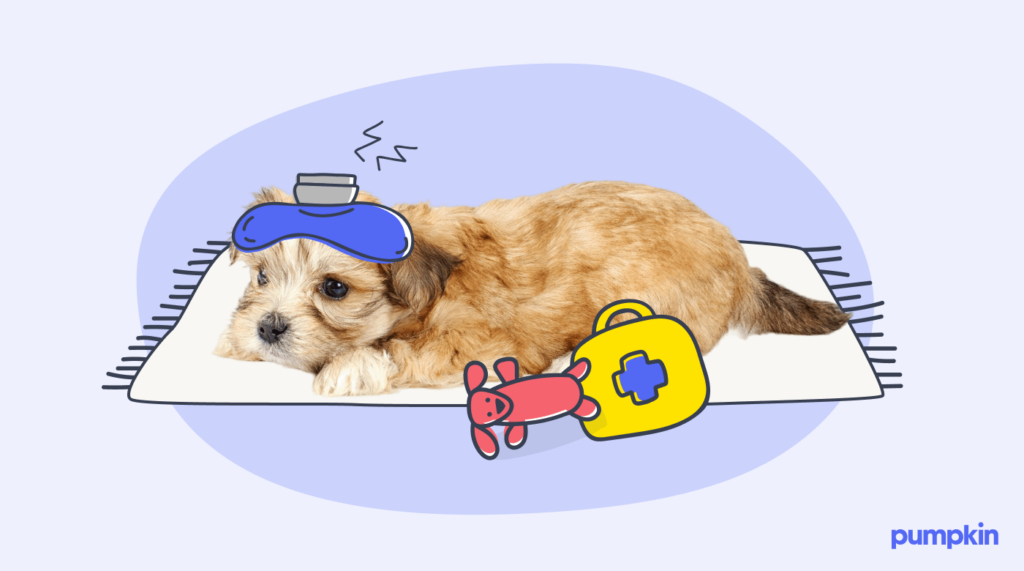Key Points:
- Pancreatitis in dogs is a serious condition caused by inflammation of the pancreas, and the symptoms can be easily mistaken for stomach upset and other more common problems.
- Pancreatitis comes in two forms: acute pancreatitis, which is sudden and intense, and chronic pancreatitis.
- Specific breeds (such as Miniature Schnauzers, Miniature Poodles, Cocker Spaniels, Dachshunds, and Terriers), senior dogs, and overweight dogs all face a higher risk of pancreatitis.
Pancreatitis in dogs is a hard diagnosis for any pet parent to receive, but it’s important to have all the facts.
Sadly, pancreatitis in dogs is often misunderstood, leading to delayed diagnosis and treatment. Symptoms like vomiting or diarrhea can seem like a temporary tummy issue at first, only for pet parents to later find out it’s a sign of pancreatitis.
Whether your dog has recently been diagnosed or you suspect they may have it, here’s what you need to know about canine pancreatitis.
What is pancreatitis in dogs?
When your pup eats, the pancreas releases special enzymes that break down food and help your pet absorb all the good nutrients. It also produces hormones like insulin to regulate appetite and blood sugar levels.
In healthy dogs, pancreatic enzymes are produced in an inactive state and activated in the small intestine for digestion. But with pancreatitis, these enzymes get activated too soon in the pancreas, causing the enzymes to start digesting the pancreas instead of food.
These digestive enzymes cause infection and inflammation of the pancreas and can even lead to the development of abscesses within the pancreas that can kill off parts of the organ. All of this causes abdominal pain, vomiting, and loss of appetite.
Severe pancreatitis can be life-threatening because inflammation in the pancreatic tissue leads to inflammation in other parts of the body, including the lungs, blood systems, and cardiovascular system.
The symptoms of pancreatitis in dogs
Cases of pancreatitis can come in two forms: Acute pancreatitis (sudden and intense) or Chronic pancreatitis (a long-term struggle). Regardless of the type of pancreatitis, if you see any of these symptoms in your dog, don’t wait. Get your pup to the vet, pronto!
Clinical signs of acute pancreatitis
- Sudden and/or repeated vomiting
- Loss of appetite
- Abdominal pain
- Diarrhea
Signs of chronic pancreatitis in dogs
- Chronic Fatigue
- Smelly stool
- Loss of energy
- Vomiting and dog diarrhea
- Lack of attention
- Diabetes mellitus
- Pain during digestion
- Bloody stool with mucus
- Pain in the abdomen
- Increased flatulence
- Hunched back
In severe pancreatitis cases, dogs may have breathing difficulties, exocrine pancreatic insufficiency (EPI), bleeding disorders, and collapse due to abnormal heart rhythms. Severe pancreatitis can be life-threatening if not treated. Call your local or emergency veterinarian immediately if you suspect your dog might have pancreatitis.
What causes pancreatitis in dogs?
According to research, certain dog breeds are more prone to pancreatitis due to their genetic makeup. For example, small dog breeds like Miniature Schnauzers are more at risk due to their tendency for elevated fat lipids in the bloodstream.
Other breeds like Miniature Poodles, Cocker Spaniels, Dachshunds, and Terriers are also at risk. Additionally, senior dogs and overweight dogs have a higher risk of developing pancreatitis.
So, what causes pancreatitis in dogs? Well, the truth is the exact cause is unknown. However, there are some theories. Some possible culprits and risk factors include:
- Dietary indiscretion
- High-fat diets and human food: This study showed that higher fat content alone doesn’t cause a higher pancreatic response in healthy dogs. However, many veterinarians believe that “dietary indiscretion,” like eating inappropriate foods and getting into the trash, does increase the chances of pancreatitis.
- Trauma to the pancreas
- Inflammation in other parts of the body
- Cancer
- Medications: Atropine, Azathioprine, Chlorothiazide, Estrogen, Furosemide, Tetracyclines, and L-asparaginase have all been associated with the development of pancreatitis.
- Obstruction of the pancreatic duct
- High blood calcium levels
- Bacterial infections
- Inflammation of the liver, stomach, or small intestine
- High cholesterol levels
Pet Pro Tip: Illnesses and accidents can happen to our furry friends anytime. And we can’t predict when they’ll need medical attention. That’s why it’s important to enroll in pet insurance. It can help cover unexpected treatment costs, from common parasites to more severe health issues. Don’t wait until it’s too late. Find out how pet insurance works and what pet insurance covers, and choose a plan today.
How is pancreatitis in dogs diagnosed?
Want to ensure that your furry friend gets the most accurate diagnosis of pancreatitis? Good news! Newer pancreatic tests can help diagnose pancreatitis in dogs more accurately. One of these tests is the SPEC-CPL test, also known as the Specific Canine Pancreatic Lipase test.
It is quick, accurate, and can usually be done right in the clinic. This means dog parents can get precise diagnoses and the best treatment plan immediately.
Now, before diagnosing your pup, your vet will need some info from you. They’ll ask about symptoms you’ve noticed, diet changes, medications, and more. Your vet will also perform a thorough physical exam and recommend lab tests based on their findings. These tests may include a blood count, serum chemistry, and urinalysis to check organ and kidney function.
In addition, your vet may order additional blood tests specific to the pancreas. This often includes serum lipase, amylase, and pancreatic lipase immunoreactivity (cPL). Don’t worry; you can do these tests at your vet’s office and get the results the same day.
Your vet may also suggest imaging studies like x-rays, radiographs, or abdominal ultrasounds to check the pancreas for other issues, such as blocked bile ducts, tumors, abscesses in the pancreas, or abdominal fluid.
How is pancreatitis in dogs treated?

Early diagnosis, prompt therapy, and supportive care are key to positive outcomes. The best treatment for pups with mild pancreatitis is rest and letting the pancreas heal. If your pooch feels queasy and vomits, fasting is recommended until the barfing stops.
However, based on my experience as a vet and recent investigations, depriving dogs of food may exacerbate their condition. So give them small amounts of food during an episode to help prevent the gastrointestinal tract from breaking down.
On the other hand, if your dog can hold its kibble down, you may want to feed them a low-fat, highly digestible diet such as prescribed therapeutic dog food or rice. If your dog doesn’t eat, your vet would recommend a short-term feeding tube.
When it comes to treating pancreatitis in dogs, your vet may prescribe one or a combination of the following to help your pup feel better:
- Maripotant (trade name Cerenia) for vomiting and nausea
- Anti-inflammatory medication, such as steroids for severe cases when dogs are in shock
- Antibiotics if there is evidence of sepsis (bacterial infection in the blood)
- Intravenous fluids and other fluid therapy treatments to maintain normal fluid and electrolyte balance
- Pain medication for abdominal pain
- Analgesics to control the severe pain
Once your dog leaves the hospital, they’ll still need some TLC from you. First, ensure your dog sticks to a bland, low-fat diet or prescribed therapeutic food. Second, don’t forget to give them their prescribed medications.
Keep an eye on your pup and follow up with your vet to ensure they’re healing nicely. The last thing you want is a relapse or chronic pancreatitis! So, follow all instructions from your veterinary care team carefully and give your pup all the love they need to feel better.
What is the typical prognosis for dogs with pancreatitis?
When treated properly, most dogs have a good prognosis. If a dog has severe necrotizing pancreatitis (death of tissues), organ failure, or sepsis — the prognosis is not good. These dogs fail to respond to therapy more often and are at a higher risk of developing chronic problems associated with the pancreas.
How to prevent pancreatitis in dogs
Sometimes dogs develop pancreatitis and we just don’t know why, but there are steps you can take to minimize the chances of your dog developing pancreatitis, including:
Keep scraps away!
If your furry friend is prone to pancreatitis (or even if they’re not), the key to a healthy diet is controlling their ravenous appetite. Some pups will gobble up anything in sight, including things that don’t even remotely resemble food.
So, keep those counters clear of tempting fatty foods and treats that may lead to diabetes in dogs and pancreatitis eventually. Also, seal trash cans tightly and avoid giving your pup fatty table scraps. Trust me; it’s not worth risking a pancreatitis attack just for a few extra nibbles.
Keep your dog’s weight in check
Just like humans, dogs need to watch their waistlines too! Whether your pup needs to shed some extra pounds or maintain a healthy weight, monitoring their calorie intake and portions is important. That means considering their age, weight, body condition, and activity level regarding feeding time.
A fresh-food plan tailored to their unique needs can help make healthy eating easy and prevent obesity! And don’t forget, increasing your dog’s activity level with some paw-some playtime can also do wonders for their physical and mental health.
Provide high-quality dog food
Feed high-quality dog food with guaranteed probiotics and prebiotics for intestinal health. Don’t switch foods around unless you are working with your veterinarian. If you do switch, do it slowly — mix in new foods for some days to allow for a smooth transition.
Incorporate healthy fats into your dog’s diet
Omega-3 fatty acids are the essential nutrients that help keep your pup’s coat shiny, their skin healthy, and their heart, brain, and joints in tip-top shape. And get this — Omega-3s can even help reduce inflammation in the pancreas!
So where can you find these amazing fats? Fish like sardines are a great source of Omega-3s and can easily be added to your pup’s diet. A diet plan that includes Omega-3 supplements is the best way to make sure your dog is getting the right amount of these essential fats.
Pancreatitis can affect any dog, but middle-aged to older dogs and overweight pups have a higher risk. Dogs with hypothyroidism, diabetes mellitus, Cushing’s disease, and hyperlipidemia are more predisposed to the condition. So the best way to keep your pup from developing pancreatitis is to follow the tips I shared earlier.
Pancreatitis can be a scary ordeal for pet parents, but by knowing your dog’s habits, minimizing risk factors, and avoiding habits that are known to cause pancreatitis, you can minimize your dog’s chances of developing the disease.
FAQs: Dogs and pancreatitis
-
- Lazarov, Lazarin. (2020). Acute Pancreatitis in Dogs — Age, Breed, and Sex Disposition
-
- Xenoulis P. G. (2015). Diagnosis of pancreatitis in dogs and cats. The Journal of Small Animal Practice, 56(1), 13–26. https://doi.org/10.1111/jsap.12274
-
- James, F. E., Mansfield, C. S., Steiner, J. M., Williams, D. A., & Robertson, I. D. (2009). Pancreatic response in healthy dogs fed diets of various fat compositions. American journal of veterinary research, 70(5), 614–618. https://doi.org/10.2460/ajvr.70.5.614
-
- Mushtaq S., Iqra Farooq, Insha Farooq, S. Rashid, M. Rehman, R. Ali, M. Shabir, M. Ur, R. Mir and S. Ahmad. (2017). Acute pancreatitis in dogs: A review. The Pharma Innovation Journal, 6(12), 509–516.
-
- Lim, S. Y., Steiner, J. M., & Cridge, H. (2022). Understanding lipase assays in the diagnosis of pancreatitis in veterinary medicine, Journal of the American Veterinary Medical Association, 260(11), 1249-1258. Retrieved Feb 25, 2023, from https://avmajournals.avma.org/view/journals/javma/260/11/javma.22.03.0144.xml.
- (2021) Exocrine Pancreatic Insufficiency (EPI), Cleveland Clinic. https://my.clevelandclinic.org/health/diseases/21577-exocrine-pancreatic-insufficiency-epi




